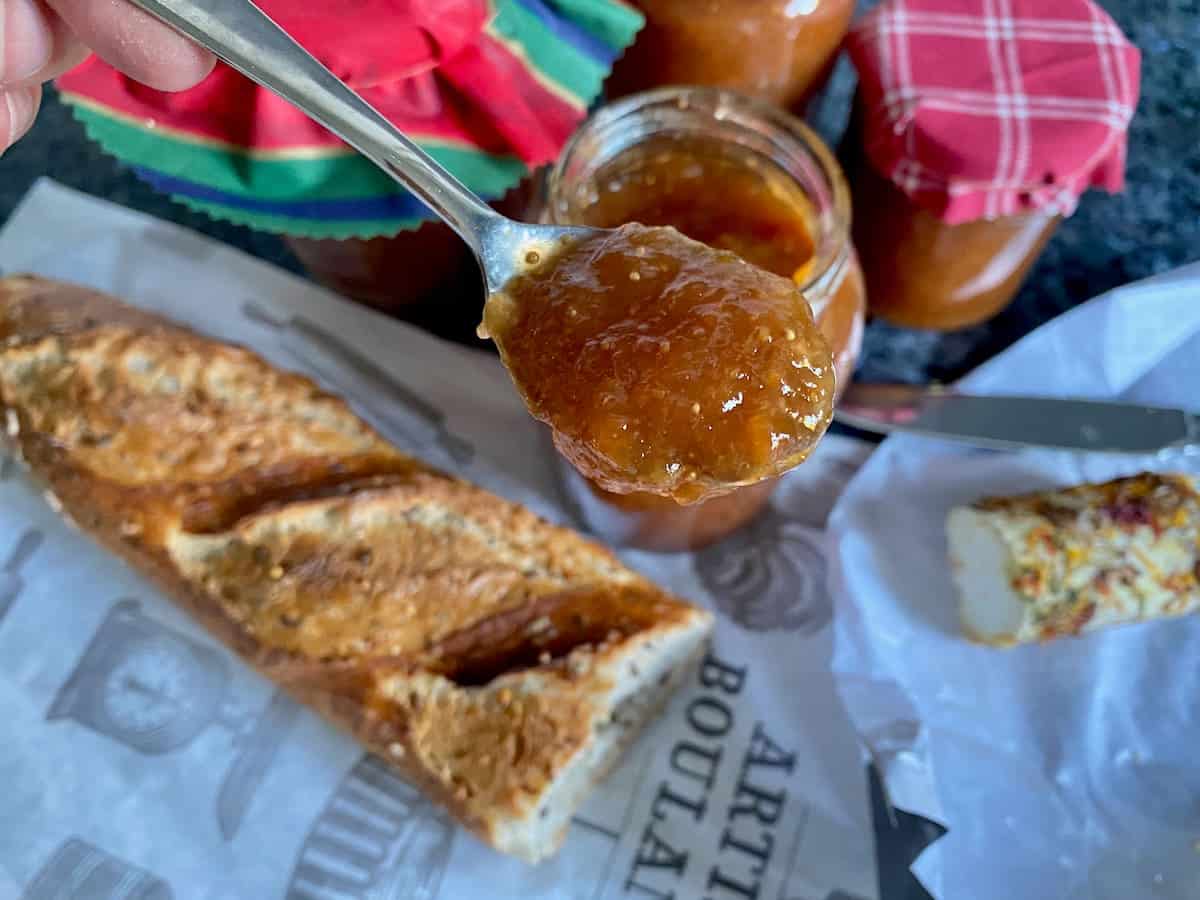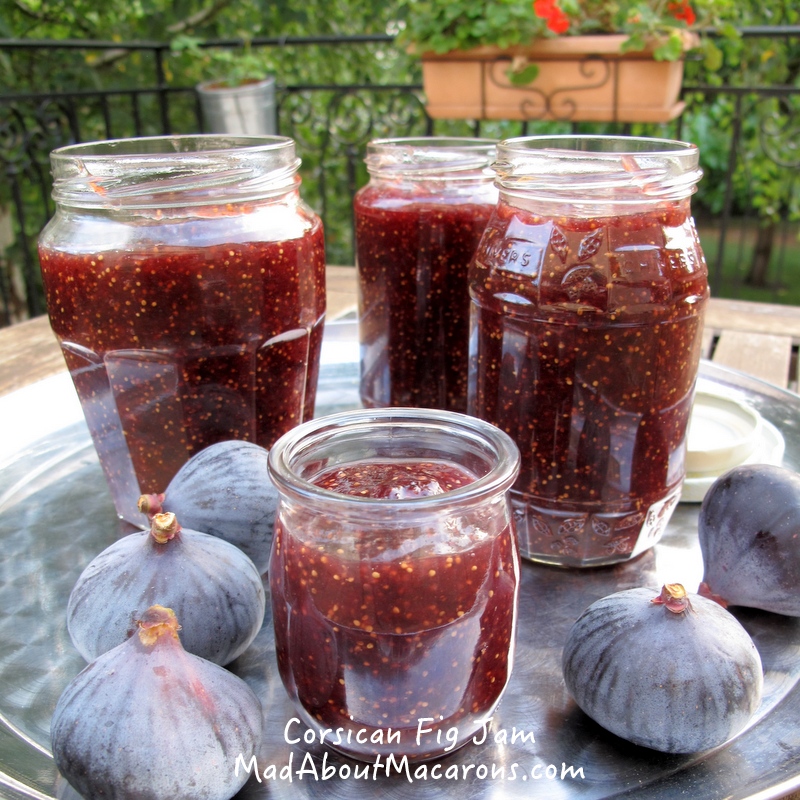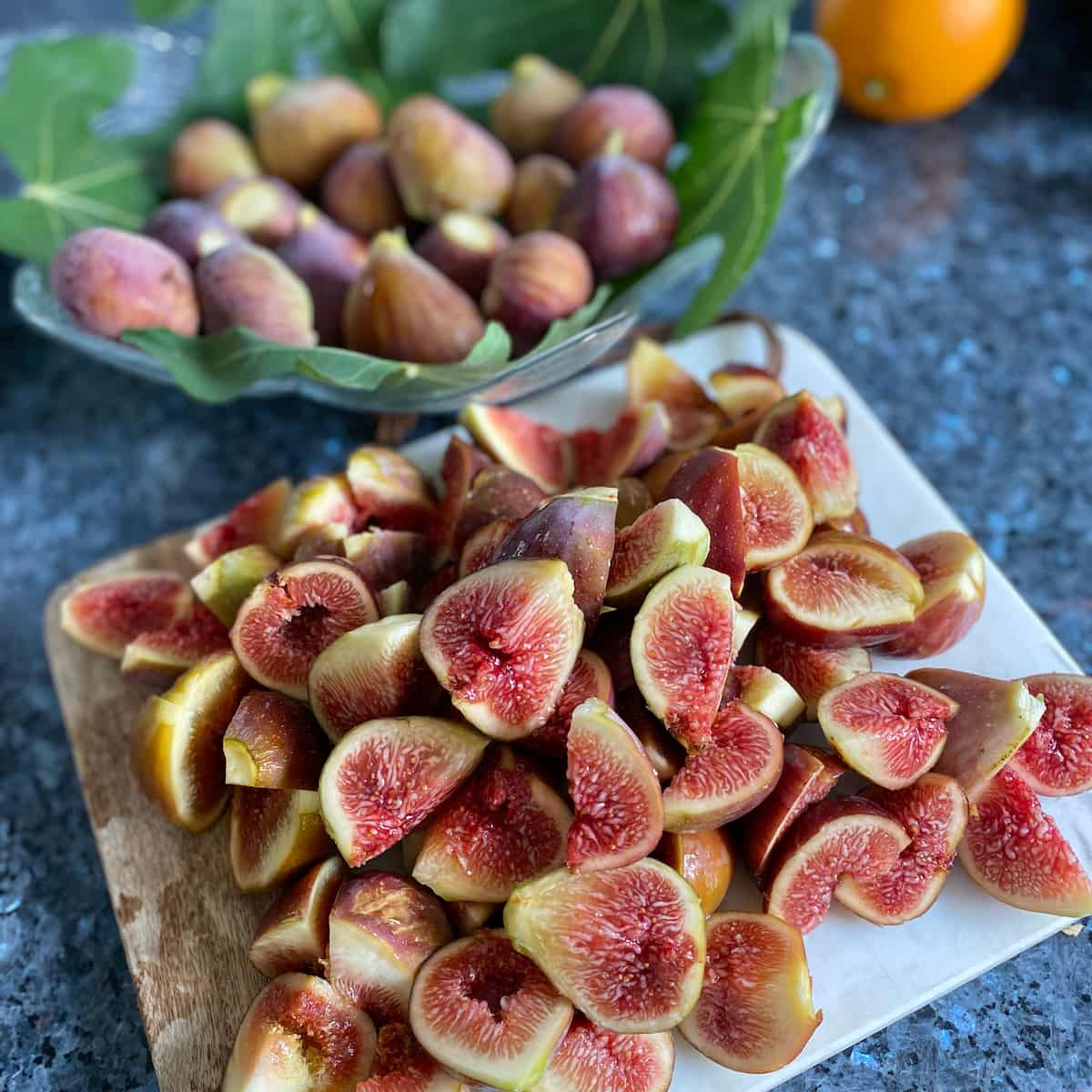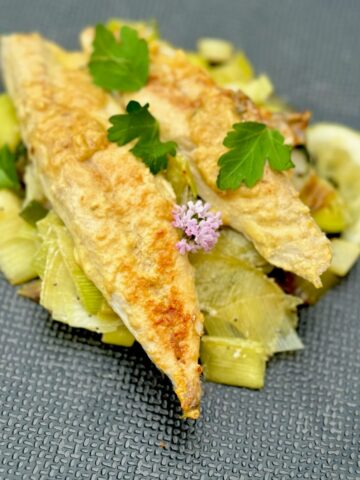We love jam - on bread, a fresh crispy baguette, brioche, crêpes or as a filling in macarons. But mention Corsican fig jam, and it takes on another delicious yet serious role. Fig jam is so popular in France's island of Corsica for a reason. It's a must on a cheeseboard and goes particularly well with strong cheeses.
Following a generous wind-fall of figs from our neighbour this season, it has given me a chance to experiment. Let me share my new reduced-sugar recipe, inspired by science.

What Kind of Cheese Goes with Fig Jam?
Perhaps you know that my husband, Antoine, is Corsican (Colonna in Corsica is so popular, it's like Smith in England). Cheeses from his "Island of Beauty" (l'île de beauté) are predominantly made from sheep's milk or goat's milk, with Brocciu the most popular (see my recipe for Fiadone for more).
As a result, any kind of chèvre goat cheese (not just from France) will match well - from fresh, often softer cheese (Brocciu/Ricotta, fresh chèvre frais, Feta) to medium (Bûche/Tomme de Chèvre, Manchego). Alternatively, fig jam will best accompany hard, more aged and mature varieties (Crottin de Chavignol, Valençay, Saint-Maure de Touraine). In fact, any other stronger cheeses go well - not just goat's cheese. Enjoy with an aged Cheddar, Stilton blue, Roquefort, Mimolette and a ripe Brie, for example.
On that note, many Corsican cheeses are, well, rather pungent. So the addition of fig jam is the perfect marriage on the cheeseboard since its sweetness helps put out the fire.
I say put out the cheese fire, since some Corsican cheeses can be so powerful that they keep the strongest ones under the chimney.
At first, I thought Antoine was joking but, like in 'Asterix in Corsica', his grandmother used to keep the robust ones under the chimney, letting their aromatic fumes drift off around the mountain village. She claimed that if she kept one in her fridge, she would have to throw it out: the fridge not the cheese!
What's the Strongest Cheese in France?

As a naïve newcomer to Antoine's Corsican village, I was introduced to Casgiu Merzu by Antoine's grinning uncle, or Tonton.
Rather than be Jill, I'll be Frank: it's the most dangerous cheese I know on this planet since it looks like an innocent little potted cheese with a knife or spoon. Imagine legendary Epoisses, Pont l'Eveque, which are already high on the strong cheese scale - but multiply Casgiu Merzu's strength by about ten.
As a result, I'd say that Casgiu Merzu is not just the strongest cheese in France - but perhaps also the world. This also has to be the cheese that exploded the boat in Asterix in Corsica. I downed that whole bowl of fig jam to put out that fire!
How to Make Fig Jam (1st Old-Fashioned Recipe)
As you can tell, I could talk longer on cheeses but this is about the jam. With a surprise wind-fall of figs from my neighbour, Michèle's tree, I'm deliberately updating my recipe this fig season, as my usual old-fashioned Corsican recipe has 2 issues:
- It used too much sugar plus extra water - I wanted to reduce it much further; and
- Two hours on the heat is too long if we need to reduce our energy in Europe.
1st recipe case in point: the old-fashioned recipe takes whole figs which are cooked in a syrup. It then takes up to 2 hours to cook the fruit. This is longer than I would cook other jams (spiced plum jam or apricot jam). The result was glossy and delicious - but we want less sugar and to consume less energy. Note the dark colour was due to using deep purple figs. The next recipe I'm using a cross variety between green and purple.

- (Above) Old-Fashioned Recipe: heat ½ kilo each of sugar and water to make a syrup. Plop in 1kg of whole figs and cook for 2 hours (I added 2 tbsp/30ml of orange blossom water). Blitz to blend or keep figs whole.

What is the Fruit to Sugar Ratio for Jam?
By law, Jam or French confiture can only be considered and labelled as jam if it has 55% of sugar ratio to fruit. Already this is more than enough but I have seen recipes using a nearly whopping 1:1 ratio of sugar to fruit which frankly, is totally unnecessary. Too much unnecessary sugar is not only bad for us, but it also masks the flavour of the natural fruits.
As figs are naturally sweet, I wanted to reduce the sugar much more. Whether or not this can be officially called jam is another issue - but, as it's homemade, who cares! It's the taste that counts. With inspiration from Raphaël Haumont, our favourite French food scientist (presenting on 'Allo Docteurs', Magazine de la Santé), I reduced the sugar to 30%! Here's how, by using his natural and healthy way of adding pectin.

Are Figs High in Pectin?
Figs are low in pectin and yet, strangely enough, it's easy to make fig jam without pectin. It thickens on its own eventually due to the high amount of their natural fruit sugars. I discovered this with the previous old-fashioned recipe with 55% added sugar and no pectin whatsoever. It just worked.
If cutting back on the sugar, however, it's better to add pectin. Best use fruits which are highest in pectin: orange (the highest pectin fruit), lemon or apples.
How do you Make Fig Jam Thicker?
If you find your fig jam is runny, I believe it's because either you added too much water in making a syrup, it wasn't macerated or cooked enough at a high enough temperature, or you reduced the sugar without adding pectin.
Before you look up the internet and follow instructions to make a mix of cornstarch - STOP! Here's how:
- Either add pectin in powder or liquid form (it's now easier to find this in health food stores or online) or
- Cook the jam for longer until it reduces/thickens.
- Add orange juice and zest (organic only: pesticides still are present even after boiling!) and boil it up a bit longer. This is adding pectin in a delicious form too. Orange is best for the flavour combination and has the highest amount of fruit pectin. However, lemon works well too. See more on the fig page for flavour combinations.
Thanks to Raphaël Haumont for the tips from his videos and books, including 'Un Chimiste en Cuisine'.

How to Make Reduced Sugar Fig Jam
So, as a result of cutting down the sugar content, here's how I made our latest batch of reduced sugar fig jam. Add just half an organic orange (an untreated orange is important, as pesticides can still linger even after boiling), including the pith and peel. This adds enough pectin to thicken the jam without the need for more sugar. I also completed by adding the whole juice of the orange.
- Wash the figs, cutting off their stems and cut into quarters. Check the over-ripe figs that they're not spoiled (I discarded a couple that had turned and tasted rather vinegary). Cut the orange in half and chop only half of it into bits, including the pith and peel.
- Place the chopped figs, sugar and orange in a large heavy-based pan or jam basin. Squeeze in the other half of the orange and leave to macerate covered for at least 2 hours (I left it for 4hours).

- Stir every so often to mix the juices together.
- After at least a couple of hours, the juices are released and it's ready to cook.

- Bubble up over medium-high heat uncovered for at least 30 minutes.
- During the first 10 minutes, discard of any scum (natural impurities) with a slotted spoon.

- After about 30 minutes of bubbling up the jam, the colour is deeper and the jam will have thickened. If it still looks a bit runny, cook for a further 10 minutes.
- The boiling jam can then be poured directly into sterilised jam jars or, if you prefer, blended using a stick blender. By blitzing the orange peel, the result will give a slightly lighter look and the jam will thicken instantly.

How Long Can Homemade Fig Jam Keep?
Homemade fig jam can be stored in a cool, dry place for up to 2 years - as long as the jars are sterilised and properly sealed.
See how below.
Once opened, keep the jam in the fridge for up to a month.
If jam contains more sugar, then it can keep for longer (2 months) but any reduced sugar jams are best consumed quickly. Frankly, this isn't a problem - it's too good!

How to Sterilise and Seal Jam Jars
To sterilise the jam jars and lids, plung them in boiling water for 10 minutes. Remove carefully with tongs and dry on a clean towel.
When the jam is ready, carefully pour the boiling jam directly into the jars using a ladle. Fill the jars as much as possible to the top then immediately seal with the lid, screwing it tight shut then upturn.
Why do we upturn jam jars as soon as they're filled? Upturning as soon as the lid or cover goes on ensures that the jam is properly sealed.
(Scientists say at this point, plunge into cold water to complete the process - so to be done with care! I don't do this).

Fig Jam Variations
For a touch of exotic sweetness, add a vanilla pod/bean. Personally I don't like adding this, as this will no longer be good with cheese! My friend, Christina at Christina's Cucina adds orange with Grand Marnier®. Many fig jams in Corsica also add roughly chopped hazelnuts, almonds or walnuts.
Adding spices goes so well with figs. Ginger, cinnamon, or cardamom are particularly good - especially over the festive period with a cheeseboard or with Foie Gras or other pâtés. Either add 1 tablespoon of chopped candied ginger, 2 cinnamon sticks or 12 green cardamoms from the start and discard cinnamon/cardamoms before pouring into jars.
Ways to Serve Fig Jam
Great spread on Scotch pancakes, brioche, baguette, and with pâté, foie gras or cheese (see above for details). In this photo, this is a slightly smoked goat's cheese with dried flowers from our local fromagerie in Saint-Germain-en-Laye.
Also delicious used in or with the following recipes (sweet or savoury):
- serve with a warm goat's cheese salade (salade de chèvre chaud);
- macaroon jam tarts;
- as a base in this French almond tart (Gâteau St-Germain);
- add a small walnut shell amount to decorate or serve with desserts or cakes.
For example with Tiramisu or on top of this sticky orange and chestnut cake.
For many more ideas, see the market produce fig page.


French Fig Jam
Ingredients
- 1 kg (2¼lb) fresh figs
- 1 orange organic only (important)
- 300 g (11oz) granulated sugar
Instructions
- Wash and dry the figs and orange. Cut off the fig stems then slice into quarters. Cut the orange in half and chop only half of it into bits, including the pith and peel.
- Place the chopped figs, sugar and orange in a large heavy-based pan or jam basin. Squeeze in the other half of the orange and leave to macerate covered for at least 2 hours (I left it for 4hours). Stir every so often to mix the juices together.
- Bubble up over medium-high heat uncovered for at least 30 minutes.
- Meanwhile, sterilise the jam jars and lids by plunging in boiling water for 10 minutes. Remove with tongs and dry on a clean towel.
- After 30 minutes the jam should be thicker (if not, continue on heat another 10 minutes). Blitz together to smooth with a hand blender (optional).
- Pour into the jars while boiling, filling to the top. Close tightly with the lid then upturn to seal.
Notes
This recipe was first published 16 September 2016 but is now completely updated to further reduce the jam's sugar quantity.






Mari
Excellent!
Jill Colonna
Short and sweet! Thanks, Mari x
Shelley B Treadway
I would be very cautious about plunging a glass jar full of hot jam into cold water! Better to be patient and let the jar seal as it cools at room temperature.
Jill Colonna
Agreed, Shelley. I have added that comment to the post, as this was suggested by the scientists to say it was to complete the sterlisation process. I personally don't do that and just upturn the jars at the end to seal. But interesting nonetheless! Hope you try the recipe x
Christina Conte
Oh, I'm dying here! I love the comment about having to throw out the fridge because the cheese is so strong! So funny! I'm glad I haven't tasted that super strong cheese as it sounds pretty lethal!
And why am I not surprised to see an orange flavor in your fig jam? Yet another thing we have in common! You'll probably guess what is in mine, too! 🙂
Lovely post, Jill! Sorry I missed it until now! xx
Jill Colonna
Yes, the cheeses in Corsica are dynamite and without fig jam, there could be tears! All incredible. I love an orange touch in there - just like the Corsicans do with prunes, too.
Mimi
Beautiful fig jam. I was in Corsica with my mother in 1974 to visit her aunt. We sat down when we first arrived outside her bar tabac, and she brought out goodies, including casu marzu. Nothing more needs to be said. ?
Jill Colonna
Jings - you were brave! You can probably still taste it from 1974... Corsican casgiu merzu is not for the faint-hearted! Thankfully there's fig jam, lol.
Thomasina
I have not tasted fig jam but it looks absolutely delicious Jill. What a great idea having it with cheese. Will definitely try it. I also like the idea of the digital jam scale. Will investigate.
Jill Colonna
Fig jam is sold everywhere in Corsica but I have to say that homemade is brilliant, especially since they're in abundance this year. Hope you try it Thomasina...
Mardi (eat. live. travel. write.)
This jam reminds me of my nana's fig jam (she used to add blanched almonds to hers). Bookmarked for when I can get my hands on enough of them! PS: Can't wait to hear more about the scale - looked cool on IG stories!
Jill Colonna
So interesting on the almonds added, Mardi. Glad you saw the Instagram Story today - yes, it's quite a scale. I'm not into gadgets but I'm totally sold on this one. It even has a pause button and a timer .... and everything is just perfect for making jam! Made plum jam this morning and it was a treat.